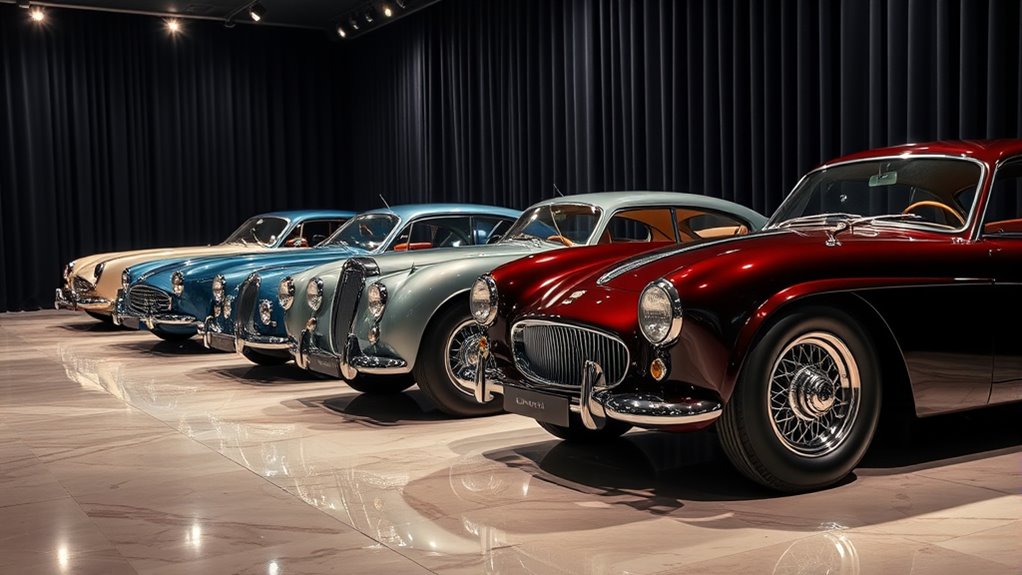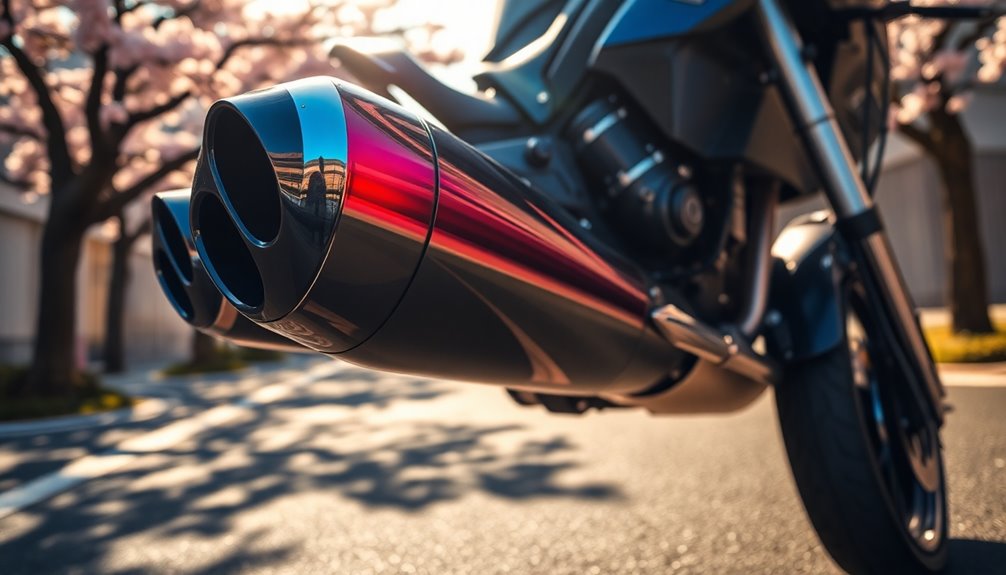In the world of high-end car collecting, you’ll find enthusiasts who value rarity, craftsmanship, and historical significance. They invest heavily in meticulous restorations, authentic parts, and secure storage to preserve their prized vehicles. Market trends, auctions, and technological innovations drive this luxury passion, turning rare cars into symbols of wealth and status. To understand how these collectors protect their assets and elevate their prestige, keep exploring what makes this world so exclusive and fascinating.
Key Takeaways
- High-end car collecting involves acquiring rare, historically significant, and luxury vehicles to showcase wealth and status.
- Notable collectors like Jay Leno and Ralph Lauren preserve automotive heritage through authentic restorations and documentation.
- Market dynamics include major auctions, exclusive events, and digital platforms that influence vehicle valuation and ownership security.
- Passion for engineering, craftsmanship, and technological innovation drives collectors’ appreciation and investment in high-end cars.
- Trends such as electric supercars, eco-friendly restorations, and blockchain-enabled provenance are shaping the future of high-end car collecting.
The Most Notable Car Collectors Around the Globe
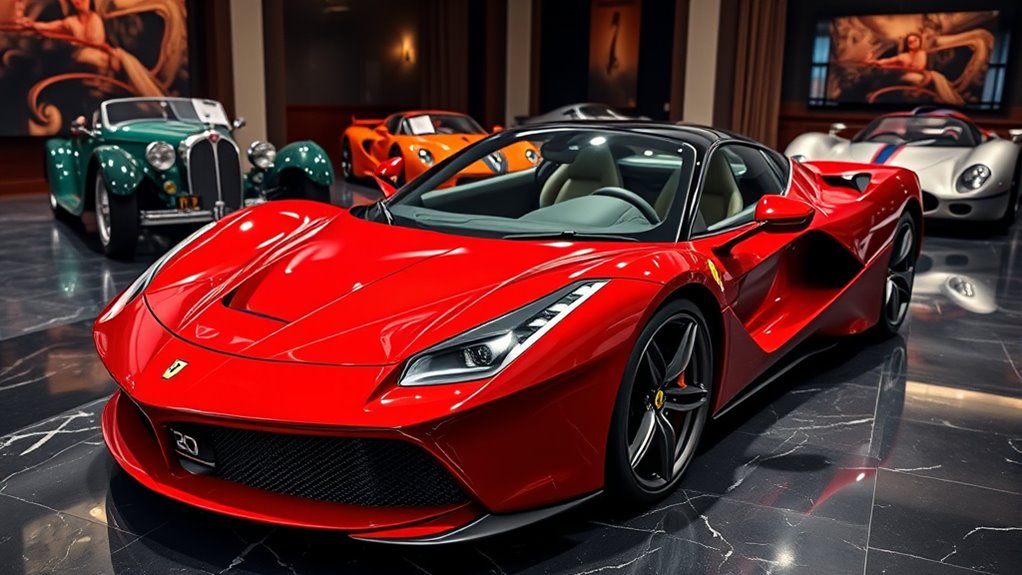
Some of the world’s most renowned car collectors have built extraordinary collections that showcase their passion and wealth. These Car Collectors own some of the most impressive luxury car collections ever assembled. Jay Leno owns over 180 cars and 160 motorcycles, valued between $50 million and $100 million, making his extensive car collection one of the most diverse in the world. Ralph Lauren’s collection, dating back to the 1970s, includes rare models like the 1938 Bugatti Type 57SC Atlantic and a 1932 Alfa Romeo 8C2300, with a value up to $700 million. Sultan Hassanal Bolkiah of Brunei has amassed over 7,000 cars, including a fleet of 600 Rolls-Royces and a $14 million Phantom II Star of India. These collectors exemplify the passion that drives high-end car collecting globally. The value of these collections is often influenced by their rarity and historical significance, making them highly coveted among enthusiasts and investors alike.
What Drives the Passion for Luxury Vehicles

Your passion for luxury vehicles often stems from the desire for prestige and the status they convey. You also appreciate the craftsmanship and engineering excellence that make these cars unique. For many, collecting is about more than just ownership—it’s about investment and showcasing their success. Developing a strong leadership style can enhance your ability to navigate the competitive world of high-end car collecting, whether through networking or strategic decision-making. Understanding the security aspects of managing valuable assets can help protect your collection from potential threats. Additionally, staying informed about cybersecurity threats affecting digital assets or online transactions is crucial in safeguarding your valuable collection. Incorporating knowledge of luxury branding can further elevate your collection’s prestige and market value.
Prestige and Status Symbol
The allure of owning rare and expensive cars goes beyond mere transportation; it serves as a powerful symbol of wealth and social status. Luxury cars like Ferrari or Bugatti become markers of success, especially among collectors who showcase their vehicles at exclusive events and concours. Owning iconic models such as the Ferrari 250 GTO or Bugatti Royale elevates your prestige within affluent circles, signaling your refined taste and achievement. Many high-end collections include bespoke, one-of-a-kind vehicles, emphasizing exclusivity and personal accomplishment. The financial investment in these rare automobiles isn’t just about passion; it’s a statement. For collectors, luxury cars represent more than transportation—they embody status, success, and admiration in the world of high-end collecting. Additionally, understanding the role of color accuracy and contrast ratio in automotive displays enhances the visual appreciation of these exquisite vehicles. Recognizing the importance of visual presentation can significantly influence how these vehicles are perceived and valued. Proper lighting conditions further accentuate the car’s design details, amplifying its allure and perceived exclusivity. Maintaining optimal display quality ensures that the vehicle’s features are showcased at their best, reinforcing its desirability.
Love for Automotive Engineering
A key driver behind the passion for luxury vehicles is a deep appreciation for their intricate craftsmanship and cutting-edge engineering. You’re drawn to automotive engineering because of the advanced technology and meticulous attention to detail that define high-performance cars. Collectors value the mastery involved in creating rare models, recognizing how engineering excellence elevates a vehicle’s status. Your fascination extends to the evolution of automotive design, where technological progress transforms each model into a moving work of art. The emotional connection to precision engineering fuels your dedication, as you admire the innovative solutions and engineering artistry that make these cars exceptional. Ultimately, it’s this love for the craftsmanship and engineering innovation that keeps your passion for high-end vehicles alive.
Investment and Wealth Building
Many high-end car enthusiasts see luxury vehicles not just as symbols of status but also as smart investments that can grow in value over time. Certain models, like the Ferrari 250 GTO, have appreciated to over $48 million, showcasing their potential for wealth building. Rarity and historical significance—such as Bugatti Royales or Mercedes-Benz SSKs—increase a vehicle’s desirability and market value. Limited editions or cars with unique provenance often see substantial appreciation, making them prime investment assets. The automotive market’s volatility can work in your favor if you sell at the right moment. Owning luxury cars diversifies your wealth portfolio and preserves your financial legacy. Additionally, understanding market trends and the factors influencing collectible car values can help investors make more informed decisions. Recognizing collectible car appreciation trends is essential for maximizing investment returns in this niche market. Moreover, engaging with professional services that specialize in high-end automotive investments can provide valuable insights and guidance to optimize your collection’s growth.
The Range of Vehicles in Premier Collections
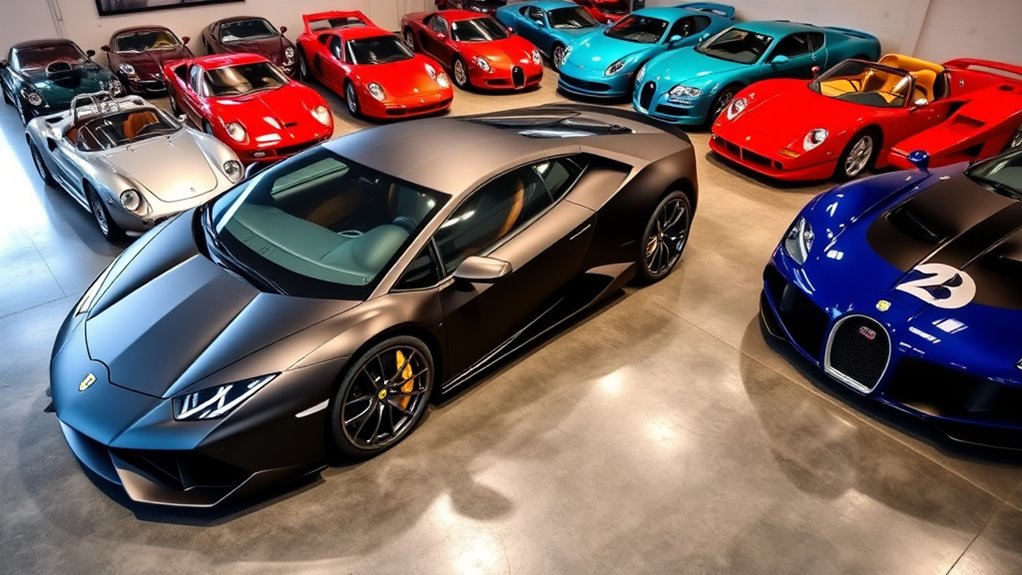
Premier car collections showcase an impressive variety of vehicles that span different eras, styles, and purposes. You’ll find everything from vintage cars to cutting-edge supercars. These collections often feature:
Premier car collections display a stunning array of vintage, luxury, and rare automobiles celebrating automotive history and craftsmanship.
- Luxury vehicles from brands like Rolls-Royce, Mercedes-Benz, and Bugatti, highlighting craftsmanship and exclusivity.
- Rare models such as the 1938 Alfa Romeo 8C 2900 and the 1955 Ferrari 250 GTO, prized for their historical significance.
- Vintage cars, including classics like the 1914 Peugeot motorcycle, reflecting automotive history. Incorporating personal growth principles can deepen appreciation for the artistry and legacy behind these timeless machines.
- Custom, one-of-a-kind automobiles, like the Rainbow Sheikh’s rainbow-colored Mercedes, emphasizing uniqueness.
- Many collections incorporate specialized technology, like hydrocolloid patches, to preserve and maintain their valuable vehicles. Additionally, understanding collectible value can enhance the way enthusiasts curate and care for their collections. Recognizing trends in AI in education can also inspire innovative ways to document and share automotive history and craftsmanship.
This diverse range creates a rich tapestry, making high-end collections a true celebration of automotive excellence across generations.
How Collectors Preserve Automotive Heritage

You play a key role in preserving automotive heritage by guaranteeing restorations meet authentic standards and reflect the vehicles’ original craftsmanship. Protecting rare cars from deterioration and documenting their provenance helps maintain their historical significance. These efforts ensure future generations can appreciate the cultural and technological legacy of classic automobiles. Proper documentation and adherence to restoration standards are essential for legal and financial protection, ensuring the value and integrity of these collector’s items. Implementing secure payment processing methods can also facilitate transactions for high-value vehicles, safeguarding both buyers and sellers during the sale process. Additionally, fostering authenticity through verified restoration practices reinforces the trust and integrity of the collector’s market. Incorporating restoration standards that emphasize originality can significantly enhance the vehicle’s historical and monetary value.
Restoring Authenticity Standards
Restoring authenticity standards is essential for preserving the true character and value of vintage vehicles. As a collector, you focus on meticulous restoration, ensuring every detail aligns with the original specifications. To do this effectively, consider these key steps:
- Use original factory parts or authentic reproductions to maintain authenticity.
- Verify provenance through certification and documentation to confirm the vehicle’s history.
- Apply period-appropriate paint, upholstery, and engineering techniques for an authentic appearance.
- Prioritize craftsmanship that respects the vehicle’s original materials and craftsmanship.
- Incorporate authentic essential oils and aromatherapy practices to enhance the preservation environment and maintain the vehicle’s original scent and atmosphere.
- Ensure proper financial documentation is maintained throughout the restoration process to support authenticity and provenance verification.
- Regularly consult with experts and appraisers to confirm that restoration techniques meet high-end collecting standards and preserve value.
- Additionally, utilizing proper cleaning methods helps protect original surfaces and materials during the restoration process.
Protecting Rare Vehicles
Protecting rare vehicles is essential for preserving automotive heritage, and collectors go to great lengths to guarantee their collections remain safe and pristine. They store cars in climate-controlled environments to prevent deterioration and maintain original condition. Advanced security systems and discreet locations shield these treasures from theft and vandalism. Regular maintenance and professional restoration techniques help sustain both authenticity and value. Provenance records and certificates of authenticity are meticulously kept to authenticate the vehicle’s history. By combining these strategies, you ensure your collection remains safeguarded for generations to come. Proper tax planning is also important to optimize the financial aspects of collecting and maintaining high-value vehicles.
Documenting Provenance Records
Maintaining thorough provenance records is essential for ensuring the authenticity and value of high-end vehicles. As a collector, you should focus on accurate documentation to preserve the vehicle’s history. Here are key steps to document provenance effectively:
- Keep original sales receipts and titles to verify ownership and origin.
- Record maintenance logs and restoration details to demonstrate care and authenticity.
- Use certificates of authenticity and historical registries for rare and valuable models.
- Store all records securely to support insurance claims and resale value.
The Role of Auctions and Shows in the Collecting World
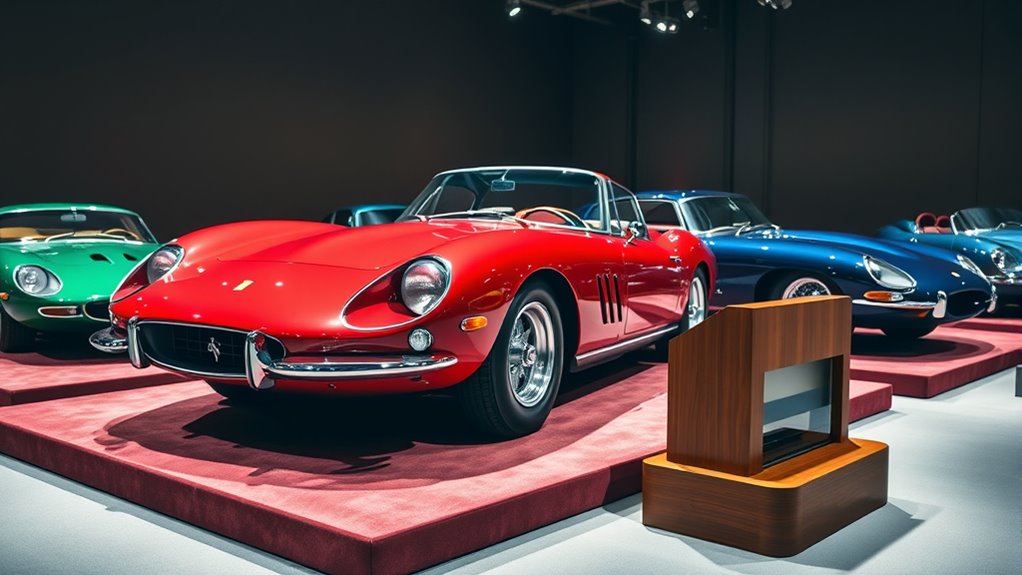
Auctions and auto shows play a crucial role in the high-end car collecting world by serving as premier venues for buying, selling, and showcasing rare and valuable vehicles. At major auctions like Barrett-Jackson, RM Sotheby’s, and Bonhams, collectors can bid on vintage and exotic cars, often reaching record-breaking prices that influence market values. Exclusive auto shows such as Pebble Beach and Goodwood provide platforms for collectors to display their prized vehicles, network with industry insiders, and discover new acquisitions. These events attract wealthy enthusiasts, allowing for direct exchanges, competitive bidding, and opportunities to enhance collections with historically significant cars. Overall, auctions and auto shows are essential for setting trends, establishing market values, and fostering the vibrant community of high-end car collectors.
The Significance of Rarity and Limited Editions

Rarity and limited editions are the driving forces behind the desirability and value of high-end cars. When you focus on limited editions, you’ll notice their exclusivity often leads to soaring prices and heightened prestige. Consider these key points:
- Limited editions like the Ferrari 250 GTO, with only 36 produced, dramatically increase in value over time.
- Rare models such as the Bugatti Royale or the three remaining Bugatti Type 57SC Atlantics are highly sought after for their scarcity.
- Exclusive editions like the Mercedes-Benz SSK “Count Trossi” hold historical significance, boosting their desirability.
- The scarcity of these vehicles elevates their status, making them prime choices for investment among collectors.
Understanding rarity’s impact helps you appreciate why limited editions are so prized in the high-end car collecting world.
Investment Value of High-End Car Collections
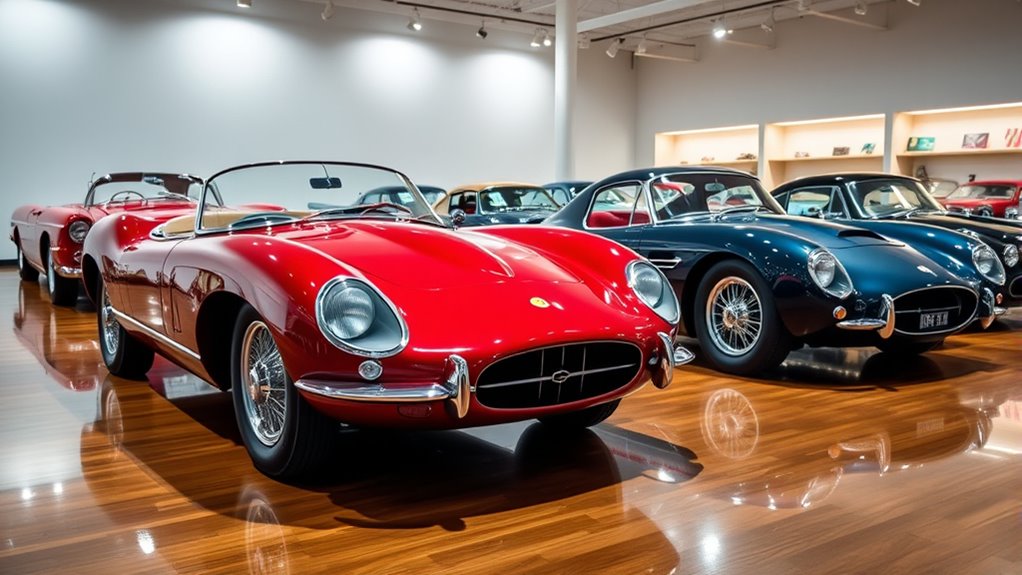
High-end car collections often serve as lucrative investments, with some valued at hundreds of millions of dollars. Your collection’s investment potential hinges on rarity and the value of classic cars. Rare vehicles like the 1938 Bugatti Type 57SC Atlantic or the 1932 Mercedes-Benz SSK can appreciate considerably over time, making them highly sought after assets. The market demand, rarity, provenance, and historical significance influence their long-term investment value. Collectors like Jay Leno and Sheikh Hamad bin Hamdan have built collections that not only reflect passion but also serve as tangible assets capable of appreciating or fetching high auction prices. Major automotive museums emphasize preservation and rarity, which directly boost a collection’s financial worth, turning passion into a smart investment.
Challenges Faced by Enthusiasts in Maintaining Collections

Maintaining a high-end car collection demands significant resources for proper preservation and restoration. You’ll face high costs for expert maintenance, rare parts, and climate-controlled storage. These challenges test your dedication and ability to keep your vehicles in prime condition.
Preservation and Restoration Challenges
Preserving and restoring vintage and luxury cars presents ongoing challenges that demand specialized skills and resources. You must source original parts, which are often scarce and costly, making maintenance and restoration more complex. Projects can take years and require significant financial investment, along with expert craftsmanship. Environmental factors such as humidity, temperature swings, and light threaten delicate finishes and internal components, requiring careful climate-controlled storage—an expensive but necessary step. To manage these challenges effectively, you need to:
- Source rare replacement parts for restoration.
- Invest in expert maintenance routines.
- Control storage environments for preservation.
- Allocate funds for continuous restoration efforts.
These steps are essential to maintaining high-end vehicles in pristine condition, ensuring your collection endures for generations.
High Maintenance Costs
Caring for a luxury car collection involves ongoing expenses that can quickly add up, often requiring you to hire specialized technicians and source bespoke parts. High maintenance costs are a significant challenge, especially with classic cars that need frequent restoration and preservation efforts. These vehicles often demand expert attention and rare components, which can cost hundreds of thousands of dollars over time. Additionally, insurance premiums for rare and valuable models are much higher, reflecting their increased risk and worth. Storage costs for climate-controlled, secure facilities can reach tens of thousands annually, adding to your expenses. Regular maintenance and repairs for exotic models, like vintage Ferraris or Bugattis, tend to be more complex and costly than for modern cars, making high maintenance costs a constant hurdle for enthusiasts.
Technological Advances Impacting Car Collecting
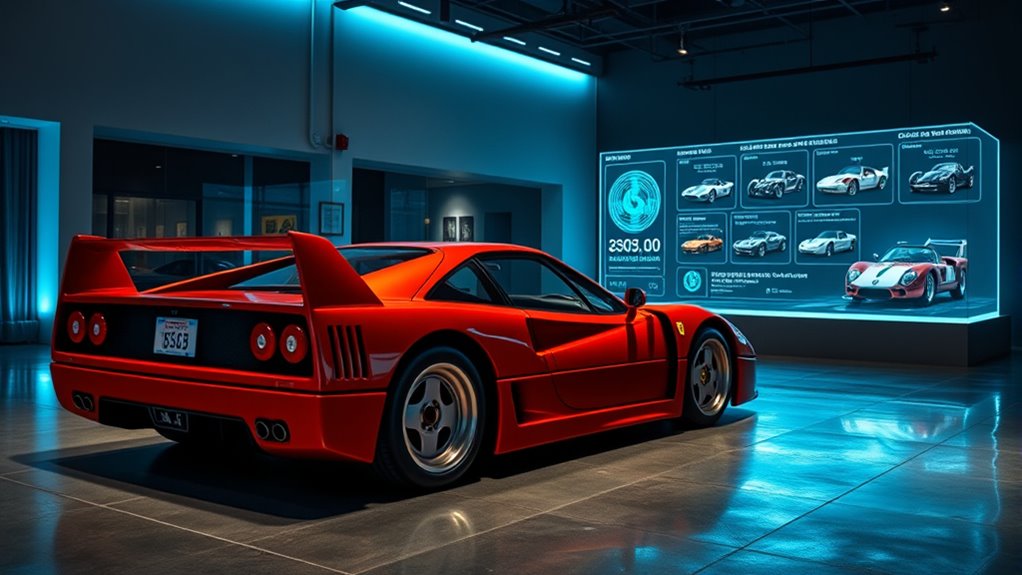
Technological advances have revolutionized the way car collectors manage and enhance their high-end vehicles. You now benefit from:
Technological advances revolutionize high-end car management, boosting performance, security, and preservation for collectors.
- Digital diagnostics that simplify maintenance, allowing you to monitor and troubleshoot issues quickly and non-invasively.
- Lightweight composite materials and advanced aerodynamics, which boost performance and add to the modern appeal of your collection.
- Enhanced security systems, including biometric access and GPS tracking, providing peace of mind by safeguarding your prized vehicles.
- 3D printing and rapid prototyping, enabling you to recreate rare or damaged parts with precision, preserving authenticity and value.
These innovations streamline preservation, improve performance, and protect your investments, making high-end car collecting more efficient and secure than ever before.
Future Trends Shaping the World of Automotive Collecting
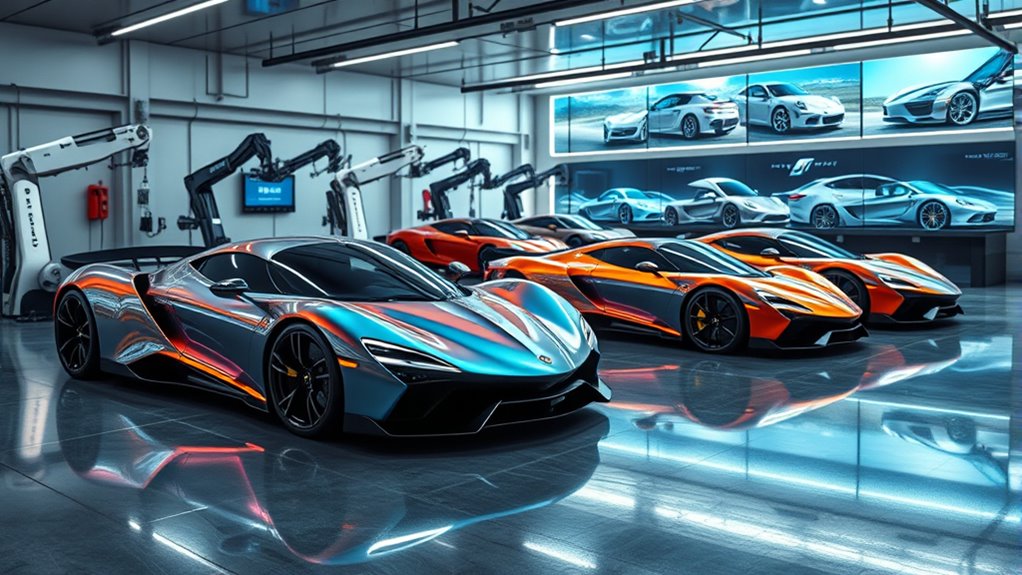
Advancements in digital technology and shifting market preferences are reshaping the landscape of automotive collecting. You’ll notice a rise in electric supercars like the Rimac Nevera and Pininfarina Battista, reflecting a move toward sustainable luxury. Digital platforms and virtual auctions now connect you globally, increasing transparency and accessibility. Blockchain technology and NFTs are revolutionizing provenance verification and ownership transfer, offering secure transactions. These trends encourage collectors to prioritize eco-friendly restorations and preserve historically significant vehicles.
| Trend | Impact | Example |
|---|---|---|
| Electric Supercars | Sustainable, high-performance collectibles | Rimac Nevera, Battista |
| Digital Auctions | Broader access, increased transparency | Sotheby’s virtual sales |
| Blockchain & NFTs | Provenance, ownership security | Digital ownership certificates |
| Global Market Access | Expanded collector base | Online platforms |
| Eco-friendly Restoration | Sustainability focus | Green restoration practices |
Frequently Asked Questions
Who Has the Highest Car Collection in the World?
You’re asking who owns the largest car collection in the world. Sultan Hassanal Bolkiah of Brunei holds this title, with over 7,000 vehicles. His collection includes around 600 Rolls-Royce cars and more than 450 Ferraris, featuring rare and custom models like a gold-plated Silver Spur II and a $14 million Phantom II. His extensive, diverse collection surpasses any other individual’s, making him the top car collector globally.
Who Is the Richest Man in the World Car Collection?
You’re asking who the richest man in the world has in his car collection. Sultan Hassanal Bolkiah of Brunei arguably holds that title, owning over 7,000 vehicles, including rare luxury models like 600 Rolls-Royces and 452 Ferraris. His collection, reflecting immense wealth and dedication, surpasses most others, making him the top car collector among the world’s wealthiest individuals.
Who Is the World Leader Car Collection?
You might think world leaders focus solely on politics, but some, like Sultan Hassanal Bolkiah, prove otherwise. His collection flaunts over 7,000 cars, including rare vintage Ferraris and custom Rolls-Royces, showcasing opulence beyond imagination. Imagine a fleet so vast, it makes a typical garage look tiny. Clearly, in the domain of car collecting, a world leader’s garage can rival a small city’s entire vehicle fleet.
What Is the Most Collectible Car in the World?
You’re asking about the most collectible car in the world. The 1962 Ferrari 250 GTO holds that title, with only 36 made and a record auction price of $48 million. Its rarity, racing heritage, and iconic design make it highly sought after. You’ll find that classic models like the Mercedes-Benz 540 K and Bugatti Type 57SC Atlantic also rank high, thanks to their historical significance and investment potential.
Conclusion
As you delve into the world of high-end car collecting, remember it’s more than just owning rare vehicles—it’s about preserving history and embracing innovation. Imagine your collection as a living story, each car a chapter of automotive evolution. In this journey, passion fuels your drive, and the future beckons with endless possibilities. Are you ready to steer into this exhilarating adventure where every turn reveals new treasures? The road ahead is yours to conquer.
